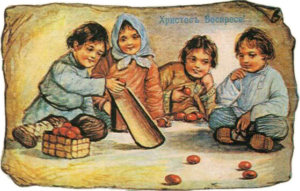
There are several ways to roll eggs. This Russian postcard shows children placing individual eggs, possibly hard-boiled, on an incline to see which would roll the furthest. In another custom, children roll hardboiled, decorated eggs down grassy hills in a competition to see whose egg rolls the farthest without breaking. The latter competition usually took place on Easter Monday, and became an annual custom in 19th century England.
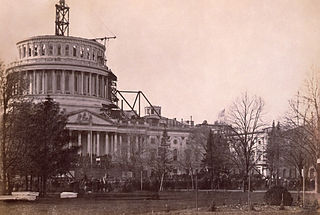
Some stories say Dolly Madison was the first to suggest a public egg roll in Washington D.C. Others note that informal egg rolls on the White House lawn date back to the Lincoln Administration. What we know for sure is that the hills surrounding the rising Capitol building were considered among the best sites for the Easter Monday game until construction materials blocked the site. When the Capital building was complete, the open space on the western side of the building, which had been a construction staging area, became into a lawn filled parkland landscaped by Frederick Law Olmsted.
According to the National Republican, Easter Monday 1876 saw the Capital grounds “thronged with lads and lassies, aye, and many older heads congregated to witness the pranks and capers of the boys and girls in rolling the eggs from the crest of the hill to the lawn below.” Not everyone was pleased with the revelry. Congressmen left their offices to see what was going on, and didn’t like what they saw. The new lawns were a ruined, muddy mess. Capitol police ordered everyone off the grass and closed the event.
To preserve the Capital lawns from future incursions, Congress passed the Turf Protection Act authorizing Capital Police “to prevent any portion of the Capitol grounds and terraces to be used as play-grounds or otherwise, so far as may be necessary to protect the public property, turf and grass from destruction or injury.”
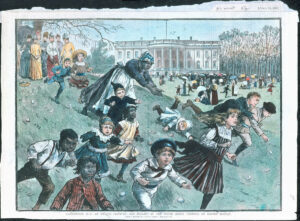
The following year, it was too rainy for an egg roll, but on April 23, 1878, police turned children and their families away from the tempting Capitol lawns. Legend suggests that at least one child’s nurse thought the White House lawns were suitable for egg rolling. Children and adults moved to the new location. “On reaching the Executive Mansion, they boldly marched in, nodding a bright and cheery good morning to the doorkeeper, who was most probably so awed by the sudden appearance of the imposing band of youngsters that he could think of nothing to say, and so in they marched, and unconsciously commenced a custom which has lived for many years since, and we hope will always be a part of the daily routine of every Easter Monday in the city of Washington.”*
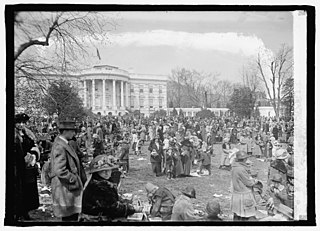
The revised tradition was an immediate hit. Families ate picnic lunches on the White House South Lawn while the children played games. In 1887 President Cleveland shook hands with each child who made her or his way to the East Room of the White House. In 1889, President Harrison ordered the Marine Band to play while the children rolled their eggs. All was well until 1918 when the District of Columbia food administrator canceled the egg roll as a wartime measure, announcing that “nothing that is an article of diet should be destroyed,” including eggs rolled on the White House lawn.
After the war, White House Egg Rolls resumed until World War II when the event was canceled from 1942-1945. From 1946 until 1952, the egg rolls took place at the Capital during White House renovations. Since then, only bad weather cancelled the egg roll until 2020 and now in 2021 when the White House Egg Roll is one of many events canceled due to the COVID-19 pandemic.
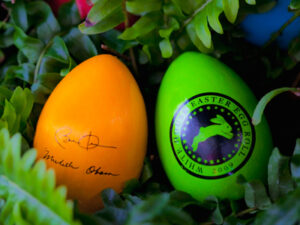
In 1981 President Ronald Reagan and First Lady Nancy Reagan introduced souvenir wooden eggs signed by celebrities. Since then, these keepsakes have become collectors’ items. Each year, the official eggs reflect a special theme and are inscribed with the signatures of the president and First Lady. Children under the age of twelve receive an egg as they leave the White House South Lawn. The eggs can also be purchased. This year, even though the Egg Roll is cancelled, you can order an official 2021 White House Easter Egg featuring silhouettes of White House dogs Champ and Major on the front and their paw prints on the back.
🥚🥚🥚
*From Cosson, Margaret Blaine. “Egg-Rolling on White House Lawns, Is Custom Started by Children Living in President Grant’s Time.” The Washington Post. April 20, 1924. IN Boundary Stones
Illustrations
Post Card from the Russian Empire.
Capital Dome Under Construction, 1861.
White House Easter Egg Roll, 1887.
1924 White House Easter Egg Roll.
2019 White House Souvenir Eggs.
“Origins of the White House Easter Egg Roll.” White House Association.
Elliot Carter. “When the White House Easter Egg Roll Was Chaos.” Politico. April 21, 2019.
Linda Castro Lindarte. “The White House Easter Egg Roll.” Boundary Stones. April 2, 2018.

Sandra Wagner-Wright holds the doctoral degree in history and taught women’s and global history at the University of Hawai`i. Sandra travels for her research, most recently to Salem, Massachusetts, the setting of her new Salem Stories series. She also enjoys traveling for new experiences. Recent trips include Antarctica and a river cruise on the Rhine from Amsterdam to Basel.
Sandra particularly likes writing about strong women who make a difference. She lives in Hilo, Hawai`i with her family and writes a blog relating to history, travel, and the idiosyncrasies of life.

